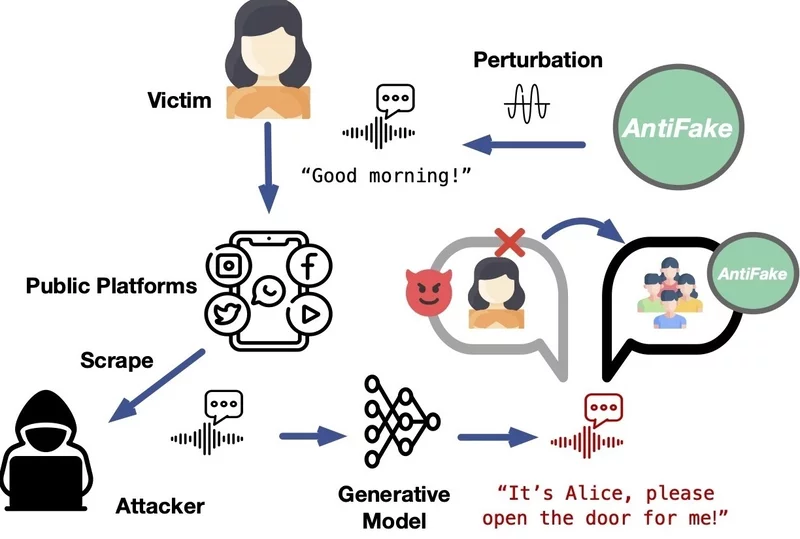How to Use AntiFake in Defending Against Deepfake Voice Manipulations?

Welcome to the intriguing and rapidly evolving world of AI technology, where the marvels of artificial intelligence meet the challenges of digital security. AntiFake, an AI tool specifically designed to combat the sophisticated threat of deepfake voice technology. As we delve into the capabilities and implications of AntiFake, we find ourselves at the forefront of a crucial battle to protect our digital identities. This tool, leveraging advanced adversarial AI techniques, stands as a beacon of hope and security in an era where the authenticity of digital content is constantly questioned. AntiFake not only represents a significant stride in safeguarding voice identities from unauthorized replication but also symbolizes the ongoing effort to harness AI for the greater good.
AntiFake emerges as a crucial tool against deepfake AI, using adversarial AI techniques to protect voice identities by scrambling signals, making it a key asset in digital security and the fight against AI-generated impersonations.
Table of Contents
What is AntiFake?
AntiFake is a cutting-edge tool developed to combat the growing threat of deepfake voice technology. It is designed to protect individuals’ voice identities from unauthorized synthesis and misuse by AI systems. Utilizing advanced adversarial AI techniques, AntiFake works by subtly scrambling voice signals in a way that is imperceptible to human ears but renders the voice data unusable for AI-based synthesis engines. This approach effectively prevents AI systems from generating convincing voice deepfakes. Developed by researchers at Washington University in St. Louis, AntiFake represents a proactive solution in the fight against the misuse of deepfake technology, particularly in safeguarding voice data against fraudulent replication and impersonation. Its development is a response to the increasing sophistication of AI in mimicking human voices, aiming to preserve the integrity and authenticity of individual voice identities in the digital realm.
What is Deepfake AI?
Deepfake AI refers to the use of artificial intelligence technologies to create highly convincing fake audio or video content. This technology leverages advanced machine learning and AI techniques, such as deep learning, to manipulate or generate visual and audio content that can be difficult to distinguish from authentic material. Deepfakes are commonly created using methods like autoencoders or generative adversarial networks (GANs), which enable the realistic alteration of facial appearances, voice modulation, and other identity markers in digital media. Initially emerging as a tool for entertainment and parody, deepfake technology has gained notoriety for its potential misuse in creating false representations of individuals, leading to concerns over privacy, security, and the spread of misinformation. Deepfakes pose significant challenges in areas like politics, entertainment, and personal security, as they can be used for malicious purposes such as impersonation, fraud, and spreading fake news.
When Will AntiFake Be Released?
The release date for AntiFake, a tool designed to combat the threat of deepfake voice technology, is anticipated to be in the near future. While the exact date is not specified in the provided information, it is clear that the development and testing phases are progressing rapidly. AntiFake is being developed by researchers at Washington University in St. Louis and aims to provide a robust solution against unauthorized voice synthesis using deep learning algorithms. The tool is designed to scramble the signal of a user’s voice in such a way that it remains normal to the human ear but becomes distorted to AI systems, making it difficult for them to create a clean-sounding voice clone. This innovative approach has shown over 95% effectiveness in preventing the synthesis of convincing deepfakes in tests conducted so far. As the technology continues to evolve, AntiFake is expected to become available soon, offering a significant advancement in the protection of voice identity in the digital age.
Functions of AntiFake
AntiFake, a pioneering tool in the fight against deepfake voice technology, offers several key functions designed to protect and secure digital voice identities. Each function addresses a specific aspect of voice security, ensuring comprehensive protection against the misuse of voice data.
Voice Identity Protection
- Biometric Analysis: AntiFake employs advanced biometric analysis to authenticate the unique characteristics of a user’s voice, ensuring that the voiceprint is as distinctive as a fingerprint.
- Detection of AI-generated Voices: The tool is capable of distinguishing between natural human voices and those synthesized by AI, providing a robust defense against voice impersonation.
- Continuous Monitoring: AntiFake offers ongoing monitoring of voice data, ensuring real-time protection against any attempts to replicate or misuse a user’s voice.
Prevention of Unauthorized Use
- Signal Scrambling: By subtly altering voice signals, AntiFake makes it challenging for AI systems to create accurate voice replicas, effectively preventing unauthorized use.
- Adversarial AI Techniques: Utilizing techniques initially developed by cybercriminals, AntiFake turns these methods against potential attackers, safeguarding voice data from misuse.
- User Consent Enforcement: AntiFake ensures that voice data is used only with the explicit consent of the user, upholding ethical standards in voice data usage.
Enhancing Security in Digital Communication
- Secure Voice Transactions: AntiFake enhances the security of voice-based transactions, making it safer to use voice commands for sensitive operations.
- Protection in Social Media and Public Domains: The tool extends its protection to social media and public platforms, where voice data is often at risk of being misused.
- Integration with Existing Security Systems: AntiFake can be integrated with existing security infrastructures, bolstering overall digital security and trust.
How does AntiFake work?
Adversarial AI Techniques
AntiFake utilizes adversarial AI techniques, a method initially developed for cybercriminal purposes but now repurposed for defense. By introducing slight distortions or perturbations in the audio signal, AntiFake effectively ‘tricks’ AI systems. These alterations are imperceptible to human listeners but significantly disrupt AI’s ability to accurately analyze and replicate the voice. This technique ensures that any attempt by AI to generate a deepfake from an AntiFake-protected voice recording results in an output that is markedly different from the original voice, thereby safeguarding the user’s unique vocal identity.
Signal Scrambling
The core of AntiFake’s functionality lies in its ability to scramble the voice signal. This scrambling is done in a way that maintains the natural sound of the voice to human ears while rendering it unrecognizable to AI systems. When an AI attempts to clone a voice that has been scrambled by AntiFake, it struggles to produce a clean and accurate replica. This is because the AI cannot effectively interpret the altered characteristics of the scrambled voice, which are crucial for generating a convincing deepfake. This method serves as a proactive barrier, preventing the creation of deepfakes at their source rather than merely detecting them after they have been made.
Ensuring Voice Authenticity
To ensure the authenticity of a voice, AntiFake incorporates a sophisticated system of voice biometrics analysis. It extracts over 1300 voice biomarkers from recordings, which include tone, pitch, cadence, and pronunciation patterns. These biomarkers form a unique voiceprint, as distinctive as a fingerprint. AntiFake’s deep neural networks are trained on an extensive dataset of synthesized fake voices produced by the latest voice cloning and deepfake algorithms. This training enables the AI to differentiate between authentic and AI-generated voices effectively. When an audio file is processed through AntiFake, the AI compares the voice biometrics against the owner’s registered voiceprint and known fake voice patterns, assigning a confidence score that indicates the likelihood of the voice being spoofed.

How AntiFake Safeguards Voice Identity from Deepfakes?
Step 1: Voice Data Analysis
The first line of defense in AntiFake’s arsenal is a comprehensive analysis of voice data. When a user’s voice recording is uploaded to the AntiFake platform, the system begins by extracting a wide range of voice biomarkers. These biomarkers include aspects like tone, pitch, cadence, and pronunciation patterns, which collectively form a unique voiceprint for the individual. This voiceprint is as distinctive as a fingerprint, making it a reliable tool for authenticating the user’s identity. The analysis is thorough and designed to detect even the slightest anomalies that could indicate AI manipulation, ensuring that the voice’s authenticity is maintained.
Step 2: Signal Alteration
Once the voice data is analyzed, AntiFake moves to the next critical step – signal alteration. This process involves subtly scrambling the voice signal in a way that is imperceptible to human ears but highly disruptive to AI systems. The altered voice signal retains its natural quality when heard by humans, but for an AI attempting to analyze and replicate the voice, the scrambled signal presents a significant challenge. This step is crucial as it prevents AI from creating a clean and accurate deepfake of the voice, effectively stopping potential impersonators in their tracks.
Step 3: Continuous Monitoring and Updating
AntiFake’s protection is not a one-time process but a continuous one. The system constantly monitors the voice data for any new attempts at replication or misuse. Additionally, AntiFake’s algorithms are regularly updated to keep up with the latest advancements in AI and deepfake technology. This ensures that the tool remains effective against even the most sophisticated deepfake attempts. The continuous monitoring and updating process is key to providing long-term protection for the user’s voice identity, adapting to evolving threats in the digital landscape.
Step 4: Integration with Security Systems
AntiFake also integrates seamlessly with existing security systems, adding an extra layer of protection. This integration is particularly important in scenarios where voice recognition is used for authentication purposes, such as in secure access systems or voice-activated devices. By working in tandem with these systems, AntiFake ensures that only the authentic voice of the user is recognized and that any deepfake attempts are quickly identified and neutralized.
Step 5: User Consent and Control
Finally, AntiFake places a strong emphasis on user consent and control. The tool ensures that the user’s voice is only used with their explicit permission, upholding ethical standards in voice data usage. Users have complete control over their voice data, and AntiFake does not store the voice on file, respecting the user’s rights and privacy. This step is crucial in building trust and ensuring that the use of voice data aligns with the user’s intentions and consent.
The Future of AI Voice Protection with AntiFake
Adapting to New AI Threats
As AI technology continues to evolve, so do the methods used for creating deepfakes. AntiFake is designed to adapt to these changes, ensuring its continued effectiveness. The tool’s developers are committed to continuously updating its algorithms to counter new deepfake techniques as they emerge. This adaptability is crucial in an ever-changing digital environment where AI tools are becoming more sophisticated. By staying ahead of the curve, AntiFake will remain a robust defense mechanism, safeguarding voice identities against the most advanced deepfake threats.
Wider Application in Various Sectors
The potential applications of AntiFake extend beyond individual use, offering significant benefits to various sectors. In the corporate world, AntiFake can protect executives and companies from reputational damage due to deepfake impersonations. In the realm of cybersecurity, it can enhance the security of voice-activated systems, preventing unauthorized access through voice spoofing. The entertainment industry, often a target of deepfakes, can also leverage AntiFake to protect the voices of artists and public figures. As the tool gains traction, its integration into different sectors will become more prevalent, providing a universal solution to voice identity theft.
Enhancing Public Awareness and Trust
A crucial aspect of the future of AI voice protection is building public awareness and trust in tools like AntiFake. Educating users about the risks of deepfake technology and the importance of protecting their digital voice identity is essential. As awareness grows, so does the trust in and adoption of AntiFake. The tool’s developers are likely to engage in outreach and educational initiatives to inform the public about the importance of voice security and the capabilities of AntiFake. This will not only increase the tool’s usage but also contribute to a more informed and security-conscious digital community.

Fighting Deepfake Cases with AntiFake
AntiFake, as a tool designed to combat deepfake voice technology, has significant implications in addressing various high-profile deepfake cases. These cases highlight the growing concern over the misuse of AI in creating convincing but fraudulent content.
Case of Scarlett Johansson and Lisa AI
- Background: Scarlett Johansson faced a deepfake scenario where her voice and likeness were used without consent in an advertisement for an AI image editor app, Lisa AI.
- Impact: This case raised serious concerns about the unauthorized use of celebrity images and voices, leading to legal action by Johansson.
- Role of AntiFake: In such scenarios, AntiFake could play a crucial role by preventing the creation of convincing voice deepfakes. Its signal scrambling technique would make it difficult for AI systems to replicate Johansson’s voice accurately, thus protecting her voice identity and potentially avoiding legal disputes.
Twitch Streamer’s AI Bot Case
- Situation: A Twitch streamer, Susu, launched an AI bot to let fans generate custom content, aiming to combat deepfakes.
- Concerns: While the intention was to provide a controlled environment for content creation, it raised concerns about exacerbating parasocial relationships and the potential misuse of AI.
- AntiFake’s Contribution: AntiFake could offer a solution by ensuring that any voice content generated through such AI bots is protected. Its ability to alter voice signals would prevent the creation of unauthorized and potentially harmful deepfakes, thus safeguarding both the streamer and the audience.
General Deepfake Challenges
- Widespread Issues: Deepfake technology has been used for various malicious purposes, including creating fake celebrity pornographic videos, impersonating public figures, and spreading misinformation.
- Deepfake Detection: Current deepfake detection methods focus on identifying AI-generated content post-creation.
- Preventive Measures with AntiFake: AntiFake’s approach is preventive, stopping deepfakes at the source. By scrambling voice data before it can be misused, AntiFake provides a proactive defense, making it a valuable tool in the broader fight against deepfake abuses.
Also read:Scarlett Johansson Sues AI Firm for Illicit Use of Her Image in Deepfake Ad Campaign,Twitch Star Launches Susu AI: Aiding Fans in the Fight Against Deepfakes
Conclusion
In conclusion, the emergence of AntiFake marks a significant milestone in the ongoing battle against deepfake AI technology. As we navigate through an era where the lines between real and artificial are increasingly blurred, tools like AntiFake become indispensable in safeguarding our digital identities. By employing advanced adversarial AI techniques and signal scrambling, AntiFake offers a robust defense mechanism against the unauthorized synthesis of voice deepfakes. Its ability to adapt to new AI threats, wide application across various sectors, and role in enhancing public awareness and trust position it as a crucial asset in the realm of digital security. As deepfake technology continues to evolve, the proactive and preventive approach of AntiFake will be key in maintaining the sanctity of voice identity and combating the potential misuse of AI in creating fraudulent content.

